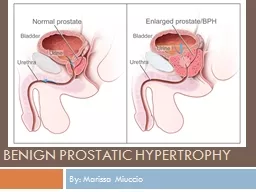

By Marissa Miuccio Description Benign prostatic hypertrophy is an enlargement of the prostate gland The prostate gland surrounds the urethra the tube that carries urine from the bladder out of the body ID: 173007
Download Presentation The PPT/PDF document "Benign Prostatic Hypertrophy" is the property of its rightful owner. Permission is granted to download and print the materials on this web site for personal, non-commercial use only, and to display it on your personal computer provided you do not modify the materials and that you retain all copyright notices contained in the materials. By downloading content from our website, you accept the terms of this agreement.
Slide1
Benign Prostatic Hypertrophy
By: Marissa MiuccioSlide2
Description:
Benign prostatic hypertrophy is an enlargement of the prostate gland.
The prostate gland surrounds the urethra, the tube that carries urine from the bladder out of the body.
As the prostate gets bigger, it may squeeze or partially block the urethra. This often causes problems urinating.
BPH occurs in almost all men as the age but BPH is not cancer. An enlarged prostate can be a nuisance. But its usually not a serious problem. Slide3
Description:
Benign prostatic hypertrophy is also known as benign prostatic hyperplasia. It is probably a normal part of the aging process in men, caused by changes in hormone balance and in cell growth.
BHP may cause the bladder to be blocked, making it impossible or extremely hard to urinate. This problem may cause backed-up urine, leading to bladder infections or stones, or kidney damage.
BHP does not cause prostate cancer, does not cause erection problems, and does not affect a man’s ability to father children.Slide4
Prostatic enlargement depends on the potent androgen
dihydrotestosterone (DHT). In the prostate gland, type II alpha-
reductase
metabolizes circulating testosterone into HDT, which works locally, not systemically. DHT binds to androgen receptors in the cell nuclei, potentially resulting in BHP.
In vitro studies have shown that large numbers of alpha-1-adrenergic receptors are located in the smooth muscle of the stoma and capsule of the prostate, as well as in the bladder neck, stimulation of these receptors causes increase in smooth muscle tone, which can worsen lower urinary tract symptoms. Conversely blockade of these receptors can reversibly relax these muscles, with relief of lower urinary tract symptoms.Slide5
Signs and Symptoms
Many men with benign prostatic hyperplasia have no symptoms. When symptoms (known as lower urinary tract symptoms occur, they may range from mild and barely noticeable to serious and disruptive.
The amount of prostate enragement is not always related to the severity of the symptoms. Some men with only slight enlargement have serious symptoms. And some men with great deal of enlargement have few symptoms.Slide6
Signs and symptoms
Symptoms of BHP may involve problems emptying the bladder or bladder storage.
Symptoms related to bladder emptying include:
Difficulty starting a urine stream (hesitancy and straining).
Decreased strength of the urine stream (weak flow).Dribbling after urination.Feeling that the bladder is not completely empty.
An urge to urinate again soon after urinating.
Pain during urination (
dysuria
).Slide7
Signs and Symptoms
Symptoms related to bladder storage include:Waking up at night to urinate (
nocturia
)
Frequent urinationA sudden uncontrollable urge to urinate.These symptoms are not always related to prostate enlargement and can be caused by other conditions. BPH symptoms are often balanced between the two types of symptoms. Slide8
Treatments
Medications are most common treatment for moderate symptoms of prostate enlargement. Medications used to relieve symptoms of enlarge prostate include
Alpha blockers
5 alpha
reductase inhibitorsCombination drug therapy. Taking an alpha blocker and a 5 alpha reductase inhibitor at the same time is generally more effective than taking just one or the other by itself.
Tadalafil
(
Cialis
)Slide9
Treatment
Surgery
Transurethral resection of the prostate (TURP)
a surgeon places a special lighted scope (
resectoscope) into your urethra and uses small cutting tools to remove all but the outer part of the prostate (prostate resection).Transurethral incision of the prostate (TUIP or TIP
)
Like TURP, TUIP involves special instruments that are inserted through the urethra. But instead of removing prostate tissue, the surgeon makes one or two small cuts in the prostate gland to open up a channel in the urethra — making it easier for urine to pass through.Slide10
Treatment
Open prostatectomyMinimally invasive surgery Laser surgery
Laser surgeries (also called laser therapies) use high-energy lasers to destroy or remove overgrown prostate tissue.